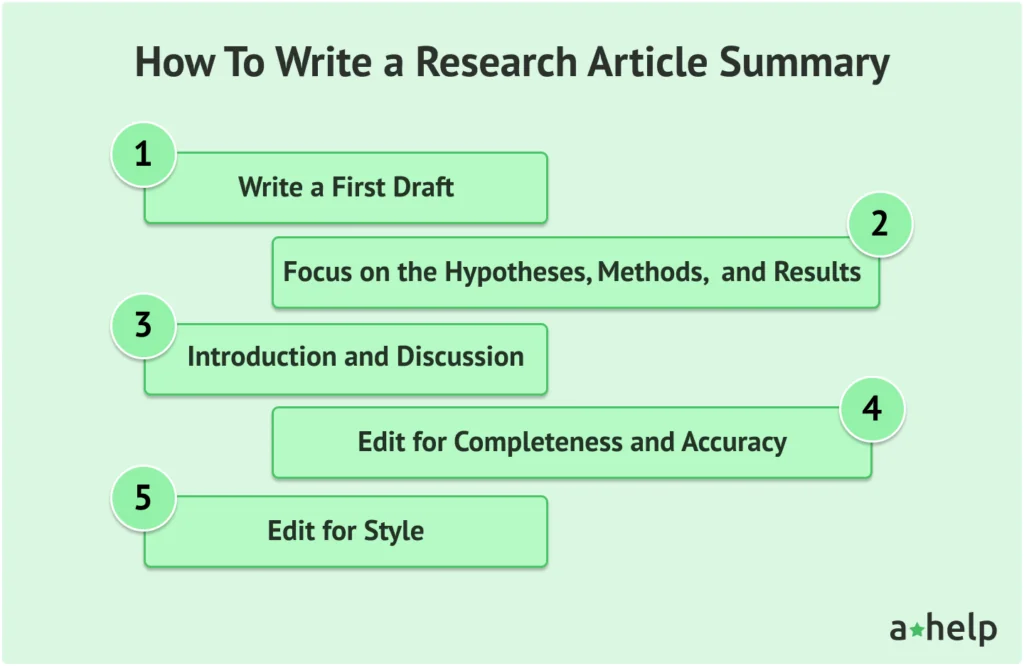

by Nayeli Ellen
5 min read 0 commentsEver found yourself swimming through the sea of a research article’s content, wondering how to find those golden nuggets of useful information? Summarizing a research article is your treasure map. It’s a great skill to know how to find the essence, pinpoint the relevant findings, and present them on a silver platter. You can do it in just a few quick steps that include understanding the article’s purpose, skimming for key points, digging deeper into its content, and then writing and refining your summary.
JOIN OUR LEARNING HUB
✅ AI Essay Writer ✅ AI Detector ✅ Plagchecker ✅ Paraphraser
✅ Summarizer ✅ Citation Generator
If you’re still uncertain how to summarize a research article, the first step should be to gain a complete understanding of this type of writing. Research articles are special kinds of writings found mostly in academic and scientific journals. They have a specific structure that sets them apart from other types of writing you’ve probably done before – like essays, for example. This structure includes sections such as the Title, Abstract, Introduction, Methods, Results, Discussion, and References. Each part plays its role:

Determine Your Focus: First, pinpoint why you’re summarizing the article. If it’s for personal study, you might opt for a detailed summary. For inclusion in a paper, concentrate on how the article’s insights relate specifically to your work. Your purpose shapes your summary’s focus.
Read the Article: Allow much time for comprehension. Understanding a research article can be more time-consuming than expected. You’re ready to summarize only when you can explain the study in your own words to someone unfamiliar with the article.
Scan the context: Avoid getting lost in the details by scanning the article to identify the main points. Focus on understanding the research question, hypotheses, methods, findings, and their interpretation. This step helps in getting the study’s core without getting bogged down.
Underline Key Points: As you scan, underline significant sentences or jot down key points in the margins. This practice helps in isolating the essential information, although relying only on the abstract is not advisable due to its condensed nature.
Read for Depth: After identifying the main points, dedicate more attention to each section. Ask critical questions about the study’s design, the results convincingness, and what new insights the study contributes. This in-depth reading provides a deeper understanding.
Avoid Plagiarism: Ensure originality by taking notes in your own words and paraphrasing key points. Understanding the content well enough to rephrase it is crucial for avoiding plagiarism.
Now that all the preparation work has been completed and all the required material has been collected, you can start working.

Write a First Draft: Begin by drafting your summary, following the article’s structure. Highlight the research question, hypotheses, methods, results, and their significance. Initially, focus on content rather than length, which can be adjusted later.
Focus on the Hypotheses, Methods, and Results: Start by writing about these sections as they form the study’s backbone. Explaining these elements provides a clear overview of the research’s objectives, execution, and findings.
Introduction and Discussion: Write about these sections after covering the core elements. They provide context and interpret the study’s implications, enriching your summary with a comprehensive understanding of the research’s scope and significance.
Edit for Completeness and Accuracy: Refine your draft by checking that all critical information is included and accurately represented. This step might involve cutting redundant details or adding necessary information for clarity.
Edit for Style: Aim for clear, concise language that speaks directly to your audience. Avoid jargon, and unnecessary adverbs, and ensure your summary is easily understandable. Paraphrasing is preferred over direct quoting in scientific summaries. Cite the original study to give due credit.
As you’ve already figured, summarizing a research article is like drawing a map of a huge, unknown area. It’s all about understanding the main ideas, going through the detailed science, and sharing the important points in a way that’s easy to understand. With some practice, you’ll get really good at this and might even start to enjoy exploring all this new information.
To get a better understanding of summarizing, explore an advanced article review maker from the AHelp team. The tool will provide you with a brief overview of the article, helping you better grasp summarizing main concepts and rules.
The length varies based on the article’s complexity and your summarizing purpose. Aim for conciseness while ensuring all critical information is covered.
Direct quotes are rare in scientific writing. They can be included only if it is necessary. Preferably, paraphrase and cite appropriately to maintain academic integrity.
Paraphrase in your own words, take thorough notes, and cite the original work. If you understand the article well, expressing its contents in your own language should come naturally.
Opt out or Contact us anytime. See our Privacy NoticeFollow us on Reddit for more insights and updates.
Welcome to A*Help comments!
We’re all about debate and discussion at A*Help.
We value the diverse opinions of users, so you may find points of view that you don’t agree with. And that’s cool. However, there are certain things we’re not OK with: attempts to manipulate our data in any way, for example, or the posting of discriminative, offensive, hateful, or disparaging material.